Patchwork tiles in the bathroom interior
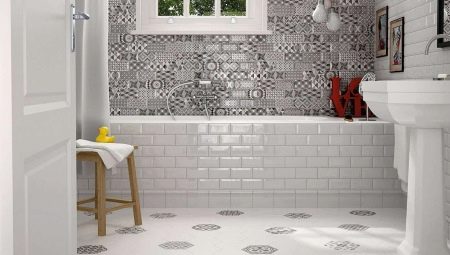
Patchwork tiles in the bathroom are not just a new trend in fashion, but almost a classic that can be found both in the American outback and in the apartments of the famous Parisian designer. The patterns characteristic of patchwork are closely intertwined with most of the folk or rural styles of different cultures. Various options for tile design in the interior of the bathroom are appropriate in combination with country style, Provence, shabby chic. A textured colorful apron on the wall, a full-fledged mosaic panel or an original floor finish - any ideas are easy to implement when you have the right ceramics at hand.
Patchwork tiles in the bathroom have become a fashion trend. But before realizing an interesting design idea, it is worth learning more about the features of ceramics used in wall and floor decoration, imitating traditional patchwork. How to choose and apply it correctly, what are the traditions of combining colors and is it possible to combine different textures - we will talk in this article.
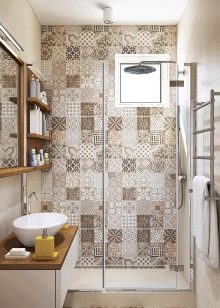
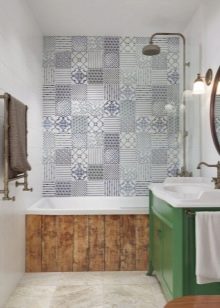
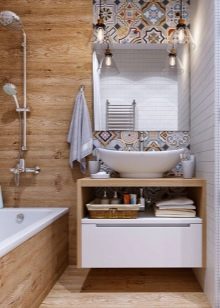
Style features
Patchwork decorative tiles are a rare example of how design is born on the basis of folk crafts. Patterned combinations of patchwork, which are used to create home textiles (blankets, bedspreads), were transferred by ceramic manufacturers to the surface of ceramic products.
Applying the patchwork style in interior decoration, for the bathroom it is better to choose modules for walls and floors from the same collection, with a general design and ornament. This finish looks stylish:
- framed by a mirror;
- in the design of a solid ceramic carpet on the floor;
- in the design of a wall panel;
- on arches, steps, catwalks,
- for visual zoning;
- in the decor of the screen located under the bath bowl.
Patchwork is a fairly free style that allows you not to follow strict canons. Here you can combine "patches" of any format, mix colors, avoid a clear coincidence of joints and get an excellent result.
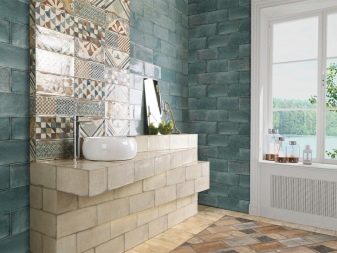
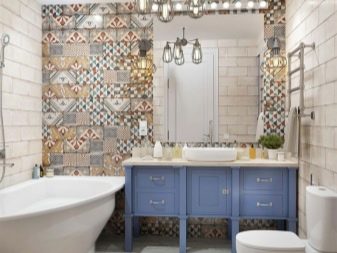


What kind of tiles are there?
Patchwork tiles are loved by many interior designers for their variety and versatile color scheme. Among the options offered, you can find a smooth and glossy texture or rough, porous, matte tiles or original glazed wall cladding. Paying attention to the type of surface, it is important to consider the intensity of the impact on the future of the canvas. So, for the floor, it is better to choose a dense, non-porous structure of the material, with a rough coating.
Patchwork-style tiles with textured patterns look very interesting. On its surface, patterns are applied in such a way that the depressed and convex elements complement each other harmoniously. It adds volume to the space. It is worth noting that patchwork is one of the few styles in which you can easily combine glossy and matte textures, combine variegated multicolor ornaments with quieter monochrome ones.
The range of shades is dominated by combinations of white, black or gray, as well as pale blue tones. Tiles with a milky background and a coffee-colored pattern look interesting. Bright tiles are decorated in natural colors.
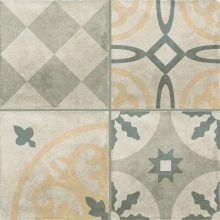

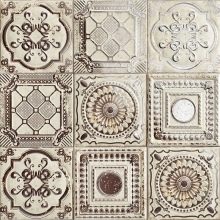
Dimensions (edit)
Tiles with imitation of patchwork are produced in a wide range of sizes - for the floor, larger tiles are mainly used, for walls - smaller modules. Among the most common floor formats are the following:
- 20 × 20 cm;
- 25 × 40 cm;
- 30 × 30 cm;
- 45 × 45 cm;
- 25 × 50 cm.
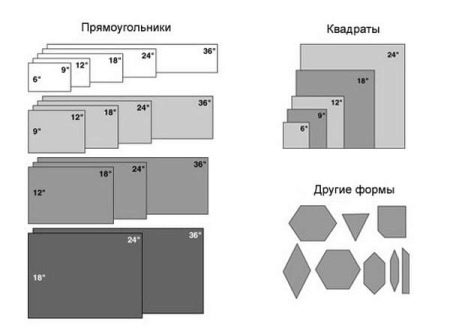
But in the classic mosaic tile laying in the patchwork style, it is customary to use exclusively square elements with a side length of 10 cm. It is she who gives the mosaic effect that this style provides, allows you to create whole panels on the walls or form an unusual ceramic "carpet" on the floor. Rectangular elements are often used as a border, to delimit functional areas horizontally, framing brighter panels along the perimeter.
The largest modules 45 × 45 or 25 × 50 are most often used in floor cladding in spacious bathrooms, can be used indoors with a swimming pool or hot tub. Here it is better to avoid variegation, preferring monochrome colors. The wall decorated with tiles looks interesting, turning into floor decoration - the choice of rectangular modules will help to add height to the room.

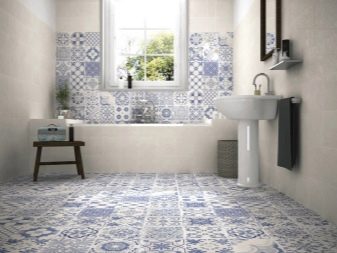
Style solutions
Patchwork tiles work well for modern and retro interiors. But in each case, the approach must be individual.
- Country. Here the tiles should combine neutral background tiles with bright accent details in natural tones. For ornamental tiles, bright yellow, green, red colors are chosen, laid out in the form of a mosaic panel on the wall.
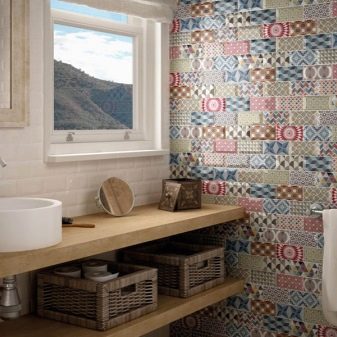

- Vintage. Tiles with imitation of patchwork will look like an aged finish with a matte texture, with an unrefined edge, chips and scuffs, carefully thought out by the designer. Outwardly, such a coating resembles majolica.
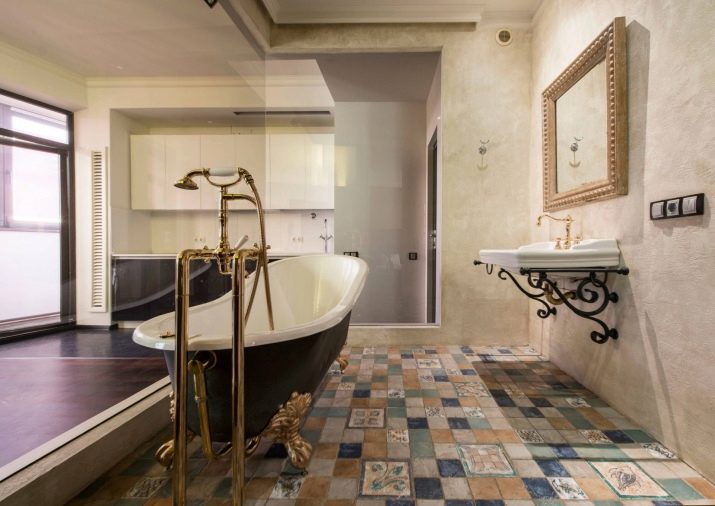
- Scandi. In such an interior, the neutral achromatic range of patchwork tiles looks very stylish. The blue and white variation can be used as an alternative to black and white.
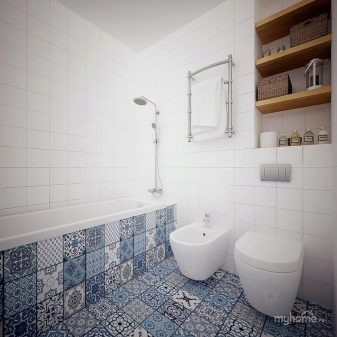
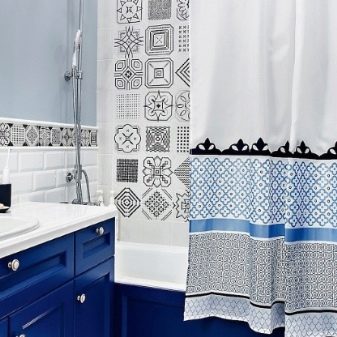
- Boho. It would be appropriate here to use tiles with imitation of patchwork as a bright accent in the wash area or in the decoration of the accent wall.
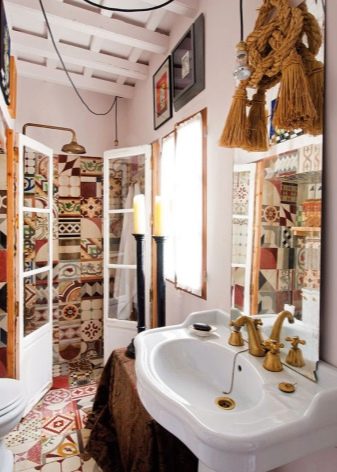
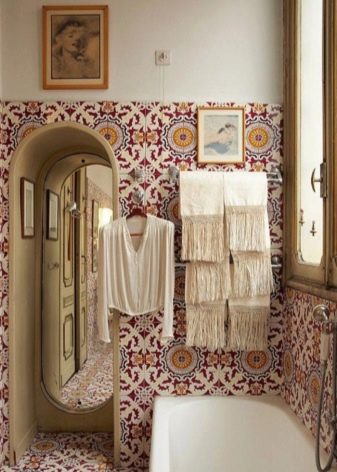
- Provence. Delicate, naive floral motifs, gray-blue tones - this is how a patchwork looks in a bathroom in a typical French province. You can tiled the bath screen or the floor.

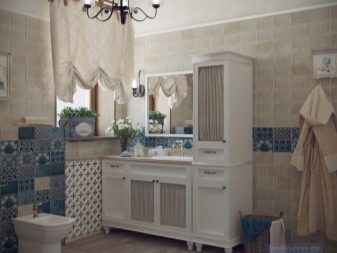
Most popular brands
The modern market for ceramic tiles and porcelain stoneware offers many options for patchwork products. Among the industry leaders who regularly include such ornaments in their collections, the following brands can be noted:
- Italy - Ragno Marazzi, Del Conca, BayKer;
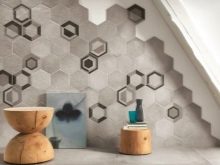
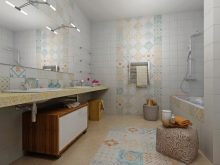
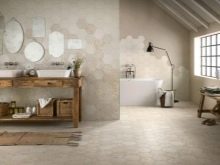
- Austria - Lasselsberger Ceramics;
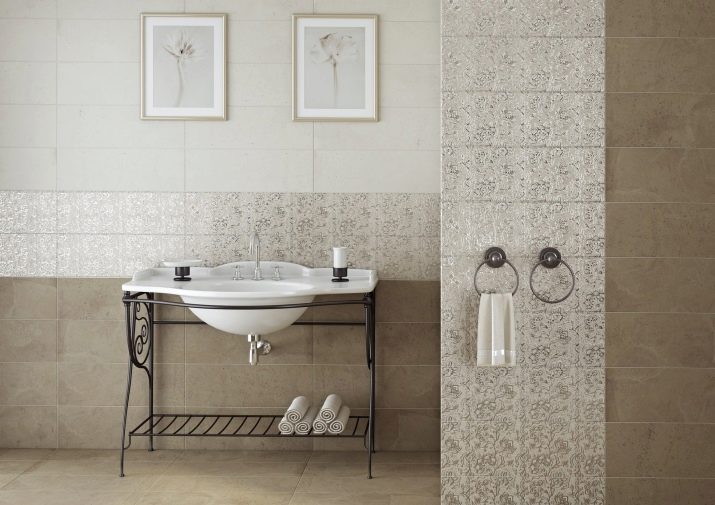
- Poland - Cerasanit;
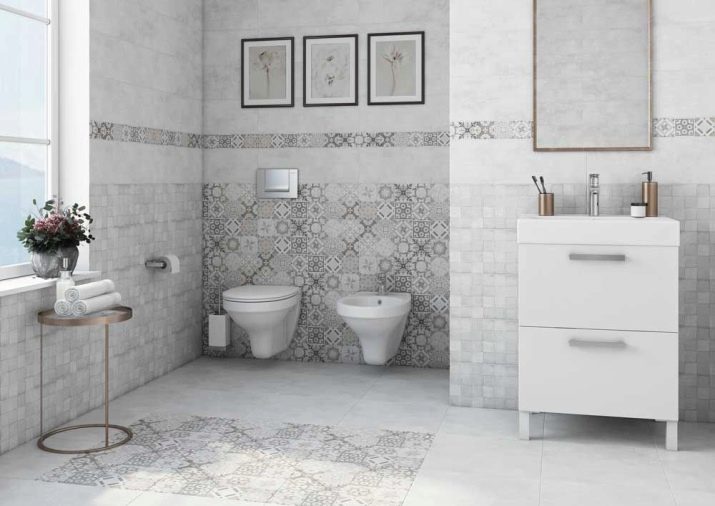
- Spain - APE Ceramica, Mainzu, Roca, La Platera;

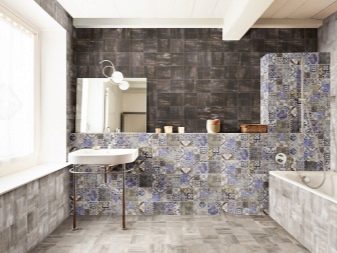
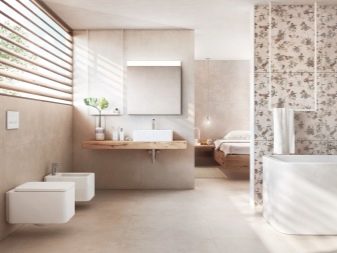

- Russia - Kerama Marazzi, Uralkeramika.
Each of these manufacturers has their own lines of ceramic tiles, allowing you to create original patchwork decor in the interior.
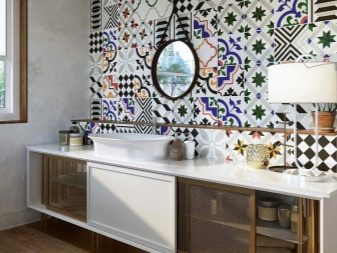
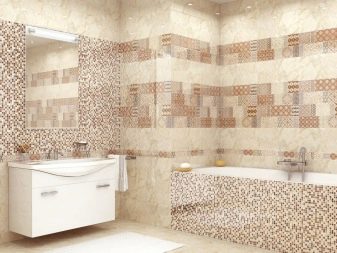
Design options
Among the design options for a patchwork bathroom, there are two main directions. Achromatic finishing provides for the use of only 3 basic colors in ornaments: white, gray, black. In such a combination, an octagonal or hexagonal tile looks interesting, forming a unique mosaic covering.
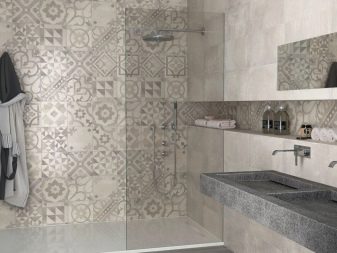
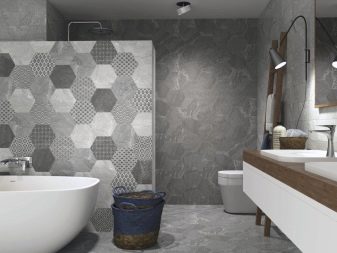
Chromatic or colored patchwork finishes are also popular. Here you can find the most unusual and contrasting combinations. Patterns on tiles in light green and purple tones, scarlet and blue ornaments, orange and sunny yellow colors will fill the room with interesting accents. In three-dimensional tiles with 3D-effects, atypical bathroom tones are often used: wine red, gold, silver, bronze, khaki shades. Ornaments in the Mexican style with Aztec elements or bright, juicy combinations of yellow, sky blue with floral prints look interesting.
The highlight of the patchwork style is the preservation of the sewing elements in the decor. It can be imitation of stitches and buttons, jacquard patterns, buttonholes. The lack of a clear pattern of the pattern allows you to create a mix to your liking.
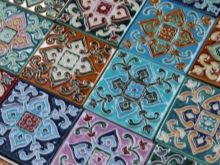

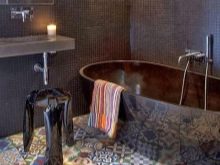
What to combine with?
It is not enough to choose a beautiful patchwork tile for the bathroom. You also need to choose the right frame for it. So that the ornament in the spirit of patchwork sewing does not discord with the general design, you should pay attention to the decor items and furnishings placed in the interior. Even the right textiles - small floral curtains or lace curtains, homespun floor rugs, unbleached towels - can be a good addition to this unusual design option.
Besides, patchwork tiles look harmoniously in combination with vintage sanitary ware and heating appliances, furniture artificially aged or painted in bright colors. In pop art style, it can be complemented with bright accent prints, reminiscent of posters. Thick limestone countertops, wicker baskets, soft ottomans with ethnic ornaments look good in such a frame. Graphite-gray tiles favorably emphasize the laconicism of high-tech details: chrome-plated paper holders, heated towel rails. In this version, the bathing area and the bathroom are trimmed, and the floor remains monochromatic.
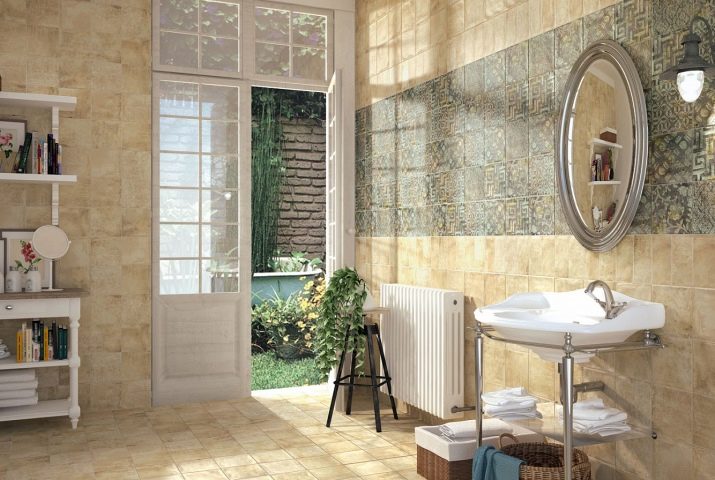
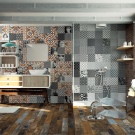
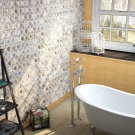

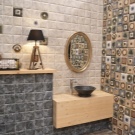
Interesting examples
- A striking embodiment of the patchwork style in the interior of the bathroom. Accent tiles on the floor and in the center of the wall cladding help balance a small space, making it more voluminous and lighter.

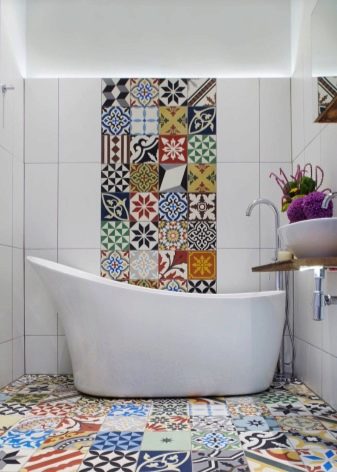
- Patchwork tiles in a modern loft style bathroom. Rough brick walls and snow-white furniture look very impressive in combination with a mosaic floor, lined with large-format hexagonal modules.

- The accent solution in the Scandinavian-style bathroom is the mosaic decor in the washbasin area. The complex layout of the room only benefits from such an addition, and the aged furniture facades against the background of patchwork tiles look quite harmonious.
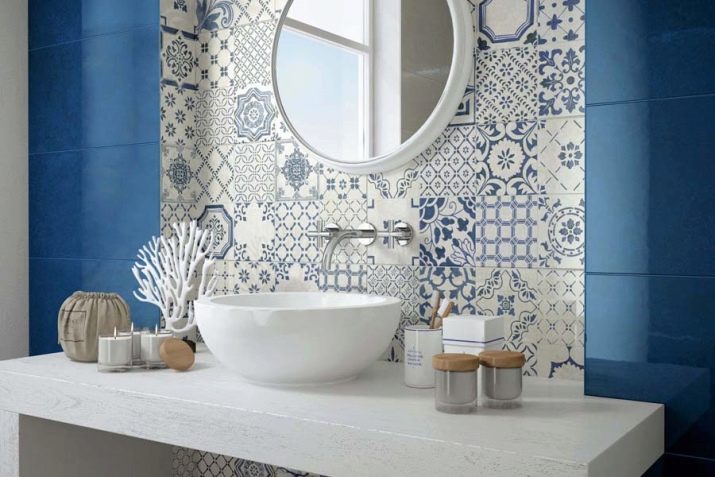
You will learn more about the use of patchwork tiles in bathroom design in the next video.








